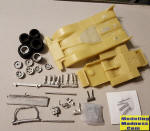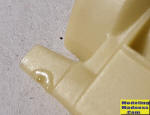
| KIT #: | 30 |
| PRICE: | $45.00 |
| DECALS: | One option |
| REVIEWER: | Scott Van Aken |
| NOTES: | Resin garage kit with metal and rubber parts. |

| HISTORY |
In the second half of the 1960s, the Canadian American
Challenge (Can-Am) had become incredibly popular. The cars competing in the
Can-Am were based on the virtually unrestricted Group 7 regulations, making them
among the fastest machines ever raced. Inspired by the success in North America,
the Europeans set up a similar racing series dubbed the 'Interserie', which
welcomed both Group 7 Can-Am cars and the Group 5 cars raced in the World
Championship. The prospect of potential customers on both sides of the Atlantic
and the high profile series made the Group 7 March a priority.
Herd's design followed that of the McLaren M8 with a full width aluminium
monocoque. The monocoque ended right after the cockpit with the engine and
gearbox mounted in an easily detachable steel subframe. Suspension was by double
wishbones on both ends and vented discs provided the stopping power. Power came
from a massive big block Chevrolet V8 engine, producing well over 700 bhp. The
most unusual part of the highly conventional package was the body, which
featured a full width front wing with moveable canards. The nose design was
similar to that of the 1970 March Formula 1 car. Continuing March' simple naming
policy, the new racer was dubbed 707; the 1970 Group 7 car.
The first chassis was completed and sold to German racing driver Helmut
Kelleners. He ran the car in the maiden Interserie championship, scoring a win
in the final round. Painted in a lively red and sponsored by STP, the second
chassis was entered by the Works in the final three rounds of the 1970 Can-Am
series for Chris Amon. Herd did not have the illusion that the 707 could
immediately challenge the dominant McLarens and wanted to use the three races to
iron out the bugs. Amon impressed with a third on the grid at the car's debut.
He eventually finished the race in fifth and then scored two fourth place
finishes. It is safe to say that the new March performed surprisingly well,
despite being slightly overweight.
| THE KIT |
 I
mentioned in an earlier preview tha
I
mentioned in an earlier preview tha t
M.A. Models are not exactly the pinnacle of quality as these are pretty
obviously home produced garage kits. This one had a few more glitches in the
casting than are the norm and M.A. Models chose to put a dollop of superglue in
the various air pockets rather than try to cast a more perfect piece.
t
M.A. Models are not exactly the pinnacle of quality as these are pretty
obviously home produced garage kits. This one had a few more glitches in the
casting than are the norm and M.A. Models chose to put a dollop of superglue in
the various air pockets rather than try to cast a more perfect piece.
The only resin parts are the body and interior/chassis. Aside
from the tires, all the rest of the bits are cast metal. This includes the
velocity stacks, wing, transmission and the rather large variety of thin metal
bits that hold it in place. You can see these on the white
 card. The bits
wrapped in tape are the tiny 'screens' that fit atop the velocity stacks. Also
cast in metal are the axles, mirrors, steering wheel, roll bar and exhaust.
card. The bits
wrapped in tape are the tiny 'screens' that fit atop the velocity stacks. Also
cast in metal are the axles, mirrors, steering wheel, roll bar and exhaust.
Instructions are a crudely drawn exploded view that provides enough info to build the kit. There are markings for one car and a photo of the build-up is provided for placement. Last time I used M.A. Models decals, they were not very good so I'll be coating this one prior to use. There are small stripe decals for the stacks that when I trued these on the Honker II, fell apart.
| CONCLUSIONS |
I fully expect to use a lot of those modeling skills we have read about when building this one. I'm under no false illusion that it will be a simple build, however, I know it won't be impossible and I'll be rewarded with a nice replica when done and will not have spent $100 for the kit.
May 2018
Copyright ModelingMadness.com. All rights reserved.
If you would like your product reviewed fairly and fairly quickly, please contact the editor or see other details in the Note to Contributors.
Back to the Main Page Back to the Review Index Page Back to the Previews Index Page